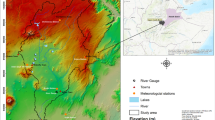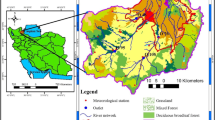Abstract
Interactions between surface water and groundwater are dynamic and complex in large endorheic river watersheds in Northwest China due to the influence of both irrigation practices and the local terrain. These interactions interchange numerous times throughout the middle reaches, making streamflow simulation a challenge in endorheic river watersheds. In this study, we modified the linear-reservoir groundwater module in SWAT (Soil and Water Assessment Tools, a widely used hydrological model) with a new nonlinear relationship to better represent groundwater processes; we then applied the original SWAT and modified SWAT to the Heihe River Watershed, the second largest endorheic river watershed in Northwest China, to simulate streamflow. After calibrating both the original SWAT model and the modified SWAT model, we analyzed model performance during two periods: an irrigation period and a non-irrigation period. Our results show that the modified SWAT model with the nonlinear groundwater module performed significantly better during both the irrigation and non-irrigation periods. Moreover, after comparing different runoff components simulated by the two models, the results show that, after the implementation of the new nonlinear groundwater module in SWAT, proportions of runoff components changed-and the groundwater flow had significantly increased, dominating the discharge season. Therefore, SWAT coupled with the non-linear groundwater module represents the complex hydrological process in the study area more realistically. Moreover, the results for various runoff components simulated by the modified SWAT models can be used to describe the hydrological characteristics of lowland areas. This indicates that the modified SWAT model is applicable to simulate complex hydrological process of arid endorheic rivers.
Similar content being viewed by others
References
Abbaspour K C, Rouholahnejad E, Vaghefi S et al., 2015. A continental-scale hydrology and water quality model for Europe: calibration and uncertainty of a high-resolution large-scale SWAT model. Journal of Hydrology, 524: 733–752. doi: 10.1016/j.jhydrol.2015.03.027
Arnold J G, Srinivasan R, Muttiah R S et al., 1998. Large area hydrologic modeling and assessment part I: model development. Journal of the American Water Resources Association, 34(1): 73–89. doi: 10.1111/j.1752-1688.1998.tb05961.x
Arnold J G, Fohrer N, 2005. SWAT2000: current capabilities and research opportunities in applied watershed modelling. Hydrological Process, 19(3): 563–572. doi: 10.1002/hyp.5611
Arnold J G, Kiniry J R, Srinivasan R et al., 2011. SWAT input/ output file documentation. version 2009. Texas Water Resources Institute Technical Report. Temple, Texas: Texas water Resources Institute.
Arnold J G, Moriasi D N, Gassman P W et al., 2012. SWAT: model use, calibration, and validation. Transactions of the ASABE, 55(4): 1491–1508. doi: 10.13031/2013.42256
Baffaut C, Benson V W, 2008. Modeling flow and pollutant transport in a karst watershed with SWAT. Transactions of the ASABE, 52(2): 469–479. doi: 10.13031/2013.26840
Beven K, 1997. Topmodel: a critique. Hydrological Process, 11(9): 1069–1085. doi: 10.1002/(SICI)1099-1085(199707) 11:9<1069::AID-HYP545>3.3.CO;2-F
Borah D K, Bera M, 2003. Watershed-scale hydrologic and nonpoint-source pollution models: review of mathematical bases. Transactions of the ASAE, 46(6): 1553–1566. doi: 10.13031/2013.16110
Bosch D D, Sheridan J M, Batten H L et al., 2004. Evaluation of the SWAT model on a coastal plain agricultural watershed. Transactions of the ASABE, 47(5): 1493–1506. doi: 10.13031/2013.17629
Brutsaert W, Nieber J L, 1977. Regionalized drought flow hydrographs from a mature glaciated plateau. Water Resources Research, 13(3): 637–643. doi: 10.1029/WR013i003p00637
Calver A, 1988. Calibration, sensitivity and validation of a physically-based rainfall-runoff model. Journal of Hydrology, 103(1–2): 103–115. doi: 10.1016/0022-1694(88)90008-X
Cui Y L, Shao J L, 2005. The role of ground water in arid/semiarid ecosystems, Northwest China. Groundwater, 43(4): 471–477. doi: 10.1111/j.1745-6584.2005.0063.x
David M B, Del Grosso S J, Hu X T et al., 2009. Modeling denitrification in a tile-drained, corn and soybean agroecosystem of Illinois, USA. Biogeochemistry, 93(1–2): 7–30. doi: 10.1007/s10533-008-9273-9
Dechmi F, Burguete J, Skhiri A, 2012. SWAT application in intensive irrigation systems: model modification, calibration and validation. Journal of Hydrology, 470–471(14): 227–238. doi: 10.1016/j.jhydrol.2010.08.055
Eckhardt K, Haverkamp S, Fohrer N et al., 2002. SWAT-G, a version of SWAT99.2 modified for application to low mountain range catchments. Physics & Chemistry of the Earth, 27(9): 641–644. doi: org/10.1016/S1474-7065(02)00048-7
Gassman P W, Reyes M R, Green C H et al., 2007. The soil and water assessment tool: historical development, applications, and future research directions. Transactions of the ASABE, 50(4): 1211–1250. doi: 10.13031/2013.23637.
He C S, Demarchi C, Croley T E et al., 2009. Hydrologic modeling of the Heihe watershed by DLBRM in northwest China. Journal of Glaciology and Geocryology, 31(3): 410–421.
Ji X B, Kang E S, Chen R S et al., 2007. A mathematical model for simulating water balances in cropped sandy soil with conventional flood irrigation applied. Agricultural Water Management, 87(3): 337–346. doi: 10.1016/j.agwat.2006.08.011
Jin X, Zhang L H, Gu J et al., 2015. Modelling the impacts of spatial heterogeneity in soil hydraulic properties on hydrological process in the upper reach of the Heihe River in the Qilian Mountains, Northwest China. Hydrological Process, 29(15): 3318–3327. doi: 10.1002/hyp.10437
Koch S, Bauwe A, Lennartz B, 2013. Application of the SWAT model for a tile-drained lowland catchment in North-Eastern Germany on subbasin scale. Water Resources Management, 27: 791–805. doi: 10.1007/s11269-012-0215-x
Krause S, Bronstert A, 2007. The impact of groundwater–surface water interactions on the water balance of a mesoscale lowland river catchment in northeastern Germany. Hydrological Processes, 21(2): 169–184. doi: 10.1002/hyp.6182
Lai Zheng qing, Li Shuo, Li Chenggang et al., 2013. Improvement and applications of SWAT model in the upper-middle Heihe River Basin. Journal of Natural Resources, 28(8): 1404–1413. (in Chinese)
Li Z L, Xu Z X, Shao Q X et al., 2009. Parameter estimation and uncertainty analysis of SWAT model in upper reaches of the Heihe river basin. Hydrological Processes, 23(19): 2744–2753. doi: 10.1002/hyp.7371
Luo Y, He C S, Sophocleous M et al., 2008. Assessment of crop growth and soil water modules in SWAT2000 using extensive field experiment data in an irrigation district of the Yellow River basin. Journal of Hydrology, 352(1–2): 139–156. doi: 10.1016/j.jhydrol.2008.01.003
Ma L, Ascough II J C, Ahuja L R et al., 2000. Root zone water quality model sensitivity analysis using Monte Carlo simulation. Transactions of the ASAE, 43(4): 883–895. doi: 10.13031/2013.2984
Moriasi D N, Arnold J G, Van Liew M W et al., 2007. Model evaluation guidelines for systematic quantification of accuracy in watershed simulations. Transactions of the ASABE, 50: 885–900. doi: 10.13031/2013.23153
Munz M, Krause S, Tecklenburg C et al., 2011. Reducing monitoring gaps at the aquifer–river interface by modelling groundwater–surface water exchange flow patterns. Hydrological Processes, 25(23): 3547–3562. doi: 10.1002/hyp.8080
Nash J E, Sutcliffe J V. 1970. River flow forecasting through conceptual models: Part 1. A discussion of principles. Journal of Hydrology, 10(3): 282–290.
Nathan R J, McMahon T A, 1990. Evaluation of automated techniques for base flow and recession analyses. Water Resources Research, 26(7): 1465–1473. doi: 10.1029/WR026i007p 01465.
Neitsch S L, Arnold J G, Kiniry J R et al., 2011. Soil and water assessment tool theoretical documentation version 2009. Texas Water Resources Institute Technical Report. Texas: Texas Water Resources Institute.
Nian Y Y, Li X, Zhou J et al., 2014. Impact of land use change on water resource allocation in the middle reaches of the Heihe River Basin in northwestern China. Journal of Arid Land, 6(3): 273–286. doi: 10.1007/s40333-013-0209-4
Pfannerstill M, Guse B, Fohrer N, 2014. A multi-storage groundwater concept for the SWAT model to emphasize nonlinear groundwater dynamics in lowland catchments. Hydrological Processes, 28(22): 5599–5612. doi: 10.1002/hyp.10062
Qi S Z, Luo F, 2006. Land-use change and its environmental impact in the Heihe River Basin, arid northwestern China. Environmental Geology, 50(4): 535–540. doi: 10.1007/s00254-006-0230-4
Reynolds J F, Smith D M S, Lambin E F et al., 2007. Global desertification: building a science for dryland development. Science, 316(5826): 847–851. doi: 10.1126/science.1131634
Smedema L K, Rycroft D W, 1983. Land Drainage: Planning and Design of Agricultural Systems. London: Batsford Academic and Educational Ltd.
Tallaksen L M, 1995. A review of baseflow recession analysis. Journal of Hydrology, 165(1–4): 349–370. doi: 10.1016/0022-1694(94)02540-R
UNESCO, 2003. Water for People, Water for Life. Paris: UNESCO Publishing and Berghahn Books.
Vazquez-Amábile G G, Engel B A, 2005. Use of SWAT to Compute Groundwater Table Depth and Streamflow in the Muscatatuck River Watershed. Transactions of the Asae American Society of Agricultural Engineers, 48(3): 991–1003. doi: 10.13031/2013.18511
Wang G, Cheng G, 2000. The characteristics of water resources and the changes of the hydrological process and environment in the arid zone of northwest China. Environmental Geology, 39(7): 783–790. doi: 10.1007/s002540050494
Wang G X, Liu J Q, Kubota J et al., 2007. Effects of land-use changes on hydrological processes in the middle basin of the Heihe River, northwest China. Hydrological Processes, 21(10): 1370–1382. doi: 10.1002/hyp.6308
Wang X S, Ma M G, Li X et al., 2010. Groundwater response to leakage of surface water through a thick vadose zone in the middle reaches area of Heihe River Basin, in China. Hydrology and Earth System Sciences, 14(4): 639–650. doi: 10.5194/ hess-14-639-2010
Wang Y, Brubaker K, 2014. Implementing a nonlinear groundwater module in the soil and water assessment tool (SWAT). Hydrological Process, 28(9): 3388–3403. doi: 10.1002/ hyp.9893
Watson B M, Mckeown R A, Putz G, et al., 2009. Modification of SWAT for modelling streamflow from forested watersheds on the Canadian Boreal PlainThis article is one of a selection of papers published in this Supplement from the Forest Watershed and Riparian Disturbance (FORWARD) Project. Journal of Environmental Engineering & Science, 7(S1): 145–159. doi: 10.1139/S09-003
Wittenberg H, 1994. Nonlinear analysis of flow recession curves. IAHS Publications-Series of Proceedings and Reports-Intern Assoc. Hydrological Sciences, 221: 61–68.
Wittenberg H, Sivapalan M, 1999. Watershed groundwater balance estimation using streamflow recession analysis and baseflow separation. Journal of Hydrology, 219(1–2): 20–33. doi: 10.1016/S0022-1694(99)00040-2
Wu K S, Johnston C A, 2007. Hydrologic response to climatic variability in a Great Lakes Watershed: a case study with the SWAT model. Journal of Hydrology, 337(1–2): 187–199. doi: 10.1016/j.jhydrol.2007.01.030
Wu Y, Wen X, Zhang Y, 2004. Analysis of the exchange of groundwater and river water by using Radon-222 in the middle Heihe Basin of northwestern China. Environmental Geology, 45(5): 647–653. doi: 10.1007/s00254-003-0914-y
Xiao Shengchun, Xiao Honglang, Lan Yongchao et al., 2011. Water issues and integrated water resource management in Heihe River Basin in recent 50 years. Journal of Desert Research, 31(2): 529–535. (in Chinese)
Zang C F, Liu J, van der Velde M et al., 2012. Assessment of spatial and temporal patterns of green and blue water flows under natural conditions in inland river basins in Northwest China. Hydrology and Earth System Sciences, 16(8): 2859–2870. doi: 10.5194/hess-16-2859-2012
Zhang L, Nan Z T, Yu W J et al., 2015. Modeling land-use and land-cover change and hydrological responses under consistent climate change scenarios in the Heihe River Basin, China. Water Resources Management, 29(13): 4701–4717. doi: 10. 1007/s11269-015-1085-9
Zhang Yinghua, Wu Yanqing, 2009. Analysis of groundwater replenishment in the middle reaches of Heihe River. Journal of Desert Research, 29(2): 370–375. (in Chinese)
Zheng J, Li G Y, Han Z Z et al., 2010. Hydrological cycle simulation of an irrigation district based on a SWAT model. Mathematical and Computer Modelling, 51(11–12): 1312–1318. doi: 10.1016/j.mcm.2009.10.036
Zhou Y, Jiang Y H, An D et al., 2014. Simulation on forecast and control for groundwater contamination of hazardous waste landfill. Environmental Earth Sciences, 72(10): 4097–4104. doi: 10.1007/s12665-014-3302-x
Zhu Y H, Wu Y Q, Drake S, 2004. A survey: obstacles and strategies for the development of ground-water resources in arid inland river basins of Western China. Journal of Arid Environments, 59(2): 351–367. doi: 10.1016/j.jaridenv.2003. 12.006
Author information
Authors and Affiliations
Corresponding author
Additional information
Foundation Item: Under the auspices of Natural Science Foundation of Qinghai Province (No. 2017-ZJ-961Q), National Natural Science Foundation of China (No. 91125010, 41530752), Scherer Endowment Fund of Department of Geography, Western Michigan University
Rights and permissions
About this article
Cite this article
Jin, X., He, C., Zhang, L. et al. A Modified Groundwater Module in SWAT for Improved Streamflow Simulation in a Large, Arid Endorheic River Watershed in Northwest China. Chin. Geogr. Sci. 28, 47–60 (2018). https://doi.org/10.1007/s11769-018-0931-0
Received:
Accepted:
Published:
Issue Date:
DOI: https://doi.org/10.1007/s11769-018-0931-0




